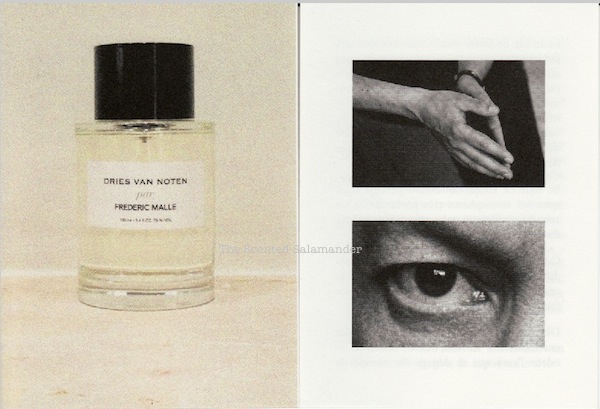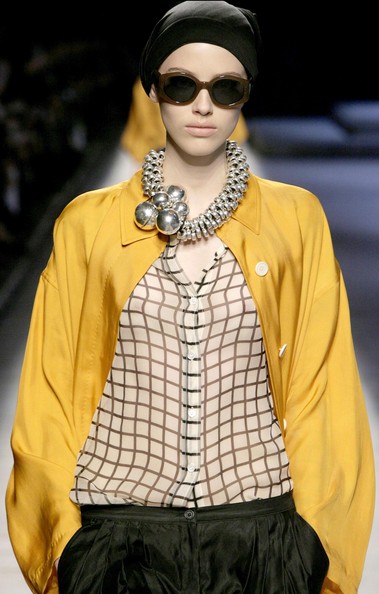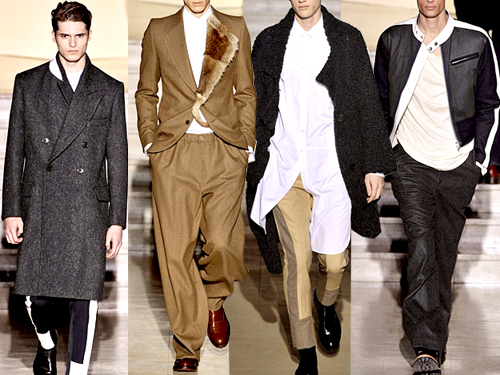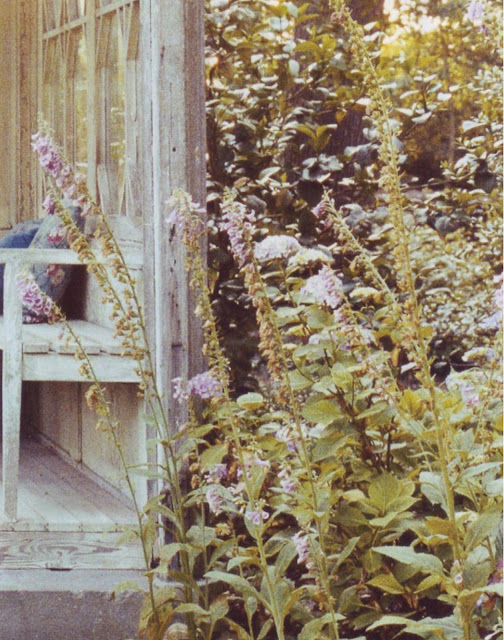Dries Van Noten par Frédéric Malle (2013): Difficult Beauty {Perfume Review & Musings}

I can say that it became all the more exciting to have read a bit about Dries Van Noten's biography after smelling the perfume created with him and for him by Frédéric Malle and realizing that pieces of the puzzle that is the olfactory auto-portrait, and portrait, came to shed light both on the perfume and the person. The perfume Dries Van Noten edp makes you see someone who does not appear whole in his fashion work, or maybe better said, emphasizes, for me at least, the abstract meaning of his style...

The composition signed by Bruno Jovanovic of IFF offers a definite sense of the straight and narrow, the line, the structure, but with fleshier parts escaping the diktats of the narrow line. You might think it has something to do with the way fragrances are composed which are often made of a bone-like structure plus fleshier accents (but not always, especially today when perfume structures are more and more varied and complex, even dynamic). But here, it feels very deliberate and economical. I could not recognize this style as clearly in his fashion, except for a few pieces that more clearly illustrate this style. But people allude to his sense of balancing the feminine and the masculine, so that might be part of the explanation. I am struck by how lines in his clothes that are more classically offered as structured are turned into their fluid equivalents as if seeking more freedom. And then reading about Dries Van Noten's lifestyle choices shed further light on some aspects and nuances of the perfume. For instance, his love of gardens.
The Antwerp-based fashion designer noted last year in a blog interview that his catwalk shows tell all the story he wants to tell about himself and his work, it ends there in principle for him, yet this new perfume continues to tell that story in its own way too now in the unfolding of its development,
"Fashion shows are really my way of communication. I don't go on Twitter. I don't go to parties. I don't often do fashion talks like this. So for me, it's really what I want to communicate. It's the end of the story..." [Editor's note: since then his company has gone on Twitter but in truth are not very intense about communicating there.]
Another quote of his that eloquently gets illustrated in the henceforth named DVN edp is the following culled out from the same interview, a statement about Dries Van Noten's paradoxical sense of personal inspiration,
"I'm more inspired by things which I don't like.... Nothing is so boring as something beautiful. I prefer ugly things, which are surprising... You force yourself to ask yourself questions. "
Van Noten, who worked closely with Frédéric Malle on nailing his first perfume also told WWD more recently that he was,
"surprised how complicated [perfume creation] was," needing assistance in getting started with the perfumery and getting the balance of notes right. But it came out right in the end. "It was really like a portrait," he said. "It is a portrait of my vision of fashion. There are a lot of elements which are there. There's a lot of tradition in it but there's something also surprising, which I hope I evoke the same emotions with my clothes." He added, "For me, it was a very interesting experience. I really liked it." [Quote via WWD]
In the perfume, there is a certain amount of stylized unpleasantness and ugliness which I translated initially - as I insist on having original, unimformed impressions of perfumes at first - before reading his published thoughts on the topic, with the phrase "difficult beauty". If you want to try a perfume which is the reverse philosophically speaking of "pleasant" you owe it to yourself to experience this scent. It is actually ultimately pleasant but through an experience of the unpleasant at times. This respects his credo in the heuristic value of ugliness as well as his plays on patterns and colors which is about pushing the extremes of adaptability to each others where most people would see mistmatches.
The fragrance itself is much more about the frontiers of this borderline Difficult-Beauty than, I think, his fashion which is much more fluid, supple and colorful than the perfume lets you suppose it to be. In this sense, the perfume sheds light on the limits of what fashion can express about Dries Van Noten's aesthetics. In DVN edp, there is, it seems a much more developed sense of the exploration of muted tones - closer to the classical spectrum of his menswear color palette, which can be very colorful - as well as borderline cringe-worthy at times.
If perfume can be inspired by fashion, it seems that it can also take further liberties with pleasantness as it can choose to be more abstract. The perfume offers a sense of progression from the more tangible to the more abstract before ending on a more comforting, sensual skin note.

To explain better this sense of ascetism one feels in the fragrance, it is not difficult to make a connection to the cool light of Northern countries, the Protestant traditions there. Frédéric Malle says that he was inspired by Van Noten's sense of fashion as reflective of the baroque, colorful mix-and-matches found in interiors in Northern European countries, but also by the atmosphere found in paintings by Flemish masters. In these rich yet pared down decors, the cold, pale-ale tinted Northern light brings its own sense of the essential.

The main accord I smell is one intertwining milky sandalwood with rooty iris and the occasional green, young, crunchy bud of spring. A crisp tulip might be an adequate approximation to render this discreet green nuance. It refers, for me, to Dries Van Noten's love of gardens. He owns a garden in Lier which he likes to mow himself, an action he sees as being a form of meditation. He told the New York Times, and they commented that,
"For Mr. van Noten mowing is a kind of meditation, complete with its own lotus position (seated upright, hands on wheel), New Age soundtrack (the infernal racket that drowns out all other noise) and aromatherapy (the smell of new-mown grass mixed with trace notes of motor oil and engine exhaust). "It's not artistic," he noted. "You don't have to think about what you're doing very much." [Just Step on the Gas and Say Om]
If it is due to the official jasmine note, which you can recognize in the composition for itself too, it is a very subtle handful of jasmine which was used, despite the mention of a generous dose of absolute of jasmine from Egypt.
The Eau de Parfum is sandalwood-rich, ethyl maltol-y, sweet. It offers a skin note. It is milky, very milky even evoking condensed milk together with a Coca-Cola note (Peru balsam and spices like nutmeg explain this). This is when it hits you that the slightly abstract sense of the familiar I get from the perfume is reminiscent of Musc Ravageur (cocktail of musks), but also of Lolita Lempicka cinnamon-scented L. If I didn't know it was perfumer Bruno Jovanovic at the helm, I would have thought it was Maurice Roucel.
The gourmand aspect of the perfume was willed by Frédéric Malle, the "editor" now turned "translator", by his own admission, who wanted to convey a sense of smelling/eating Flemish pastries like Speculoos, waffles and sugar pies. Added to the natural milkiness of Mysore sandalwood, the perfumer added Sulfurol whose odor profile is described as being meaty, nutty, yeasty and bready. Would Dries Van Noten have thought about sweets for his perfume by himself? Frédéric Malle presents it as his own vision.
But then the perfume seems to open up, and to open a vista onto a new unforeseen direction than in the head notes. There is a complete change of olfactory atmosphere even though some of the first instants remain in the development of this stage of the perfume. Now it smells rooty and green. It could be an abstract iris. It smells very different from more classical treatments of the iris note. It's pared down and the floral aspects are very muted but present. There is also now a tendency to smell even more modern, like an industrial scent that you can't quite place except in a very artificial environment.
If there is any linear logic to the development here, it would be a sense of progressive modernism that gets more and more accentuated, more and more farther away from recognizable notes of perfumery. There is an ozonic and "weird" note, together with a dry-fish nuance, which ensures the traditional vocabulary of fragrance is upset so as to find a new sense of harmony which makes room for enough disharmony to feel uncompromising. Is it interesting? Yes and no. It is intellectually interesting to note how it deviates from the norm, and there is a certain beauty to this oeuvre. But it is a beauty so severe, so self-contained that it is a difficult type of beauty to approach. In other words, Dries Van Noten par Frédéric Malle is exemplary in representing what a non-easy fragrance is. Van Noten has been called the most cerebral of fashion designers so it is not surprising to find a mind-teasing, challenging quality to the perfume. As we said before, it is a difficult beauty to behold.
The sensual, siren-like aspects of a fragrance are kept to their minimal effects. Like a body that unveils its naked skin with parcimony and economy, showing very little. Here and there you catch a bit of almond, a bit of milk, but mostly the body we guess at is shrouded and structured. The gourmand nuances make this character more human but never likeable. At times we are reminded of Bois Farine by L'Artisan Parfumeur when the floury-milky accents become more prominent. In the drydown it smells more like recognizable sandalwood -- it even smells of Chinese sandalwood fans a bit. Bergamot accents escape, jasminey ones too and it ends up smelling quite delectable and alive, natural, but in space, not so much on skin.
Before I forget, there is something to this fragrance that reminds you of Après L'Ondée by Guerlain: the hints of strong medicine and marshmallow. The powdery carnation note. That connection was explored by the house previously and more particularly by Maurice Roucel precisely in Dans Tes Bras. So at another level, DVN edp is a completely modernist Après L'Ondée, deconstructed and reappropriated.
Après L'Ondée (1906) has always occurred to me as being one of the more difficult and uncompromising Guerlains - an early guiding light for what niche perfumery could be.









